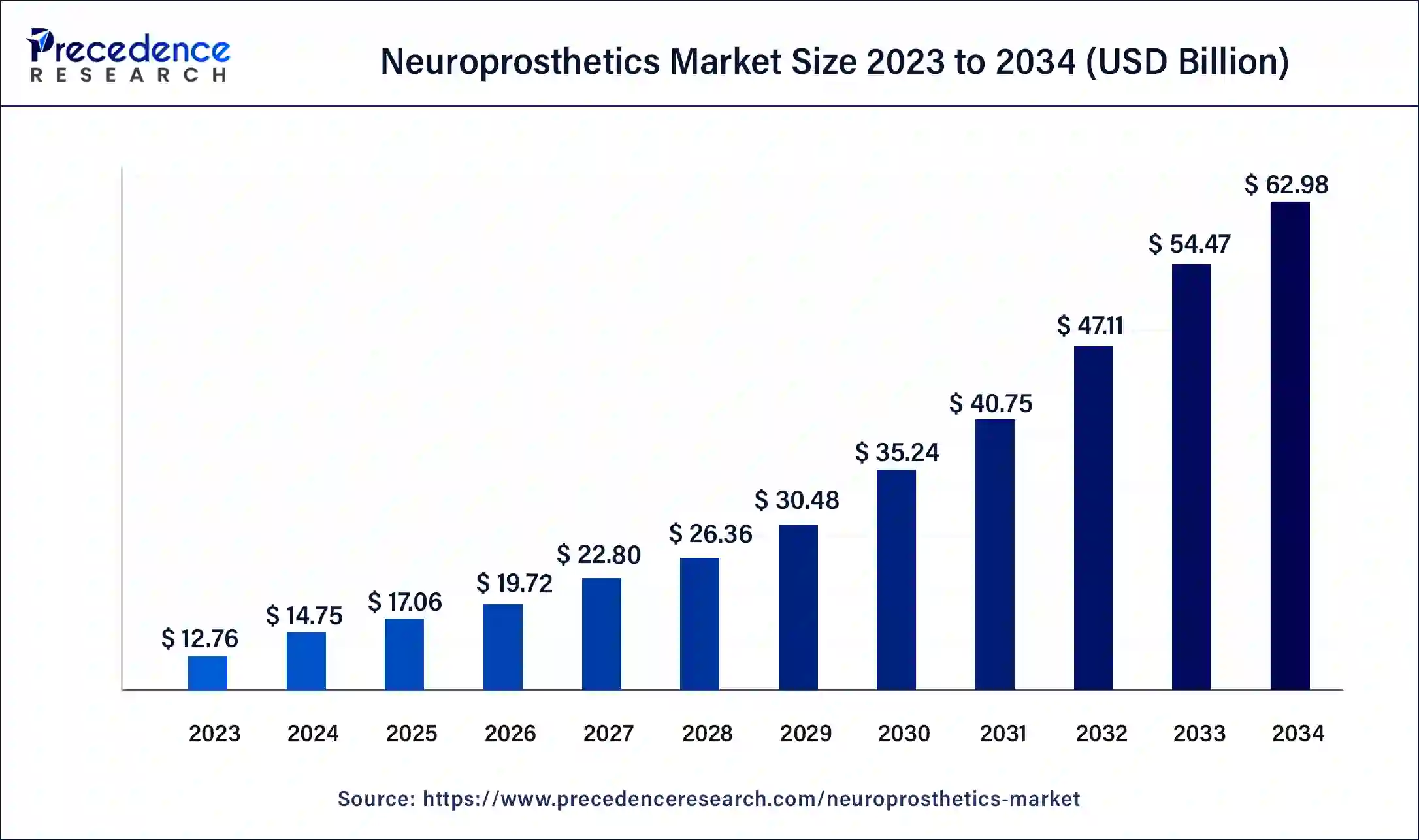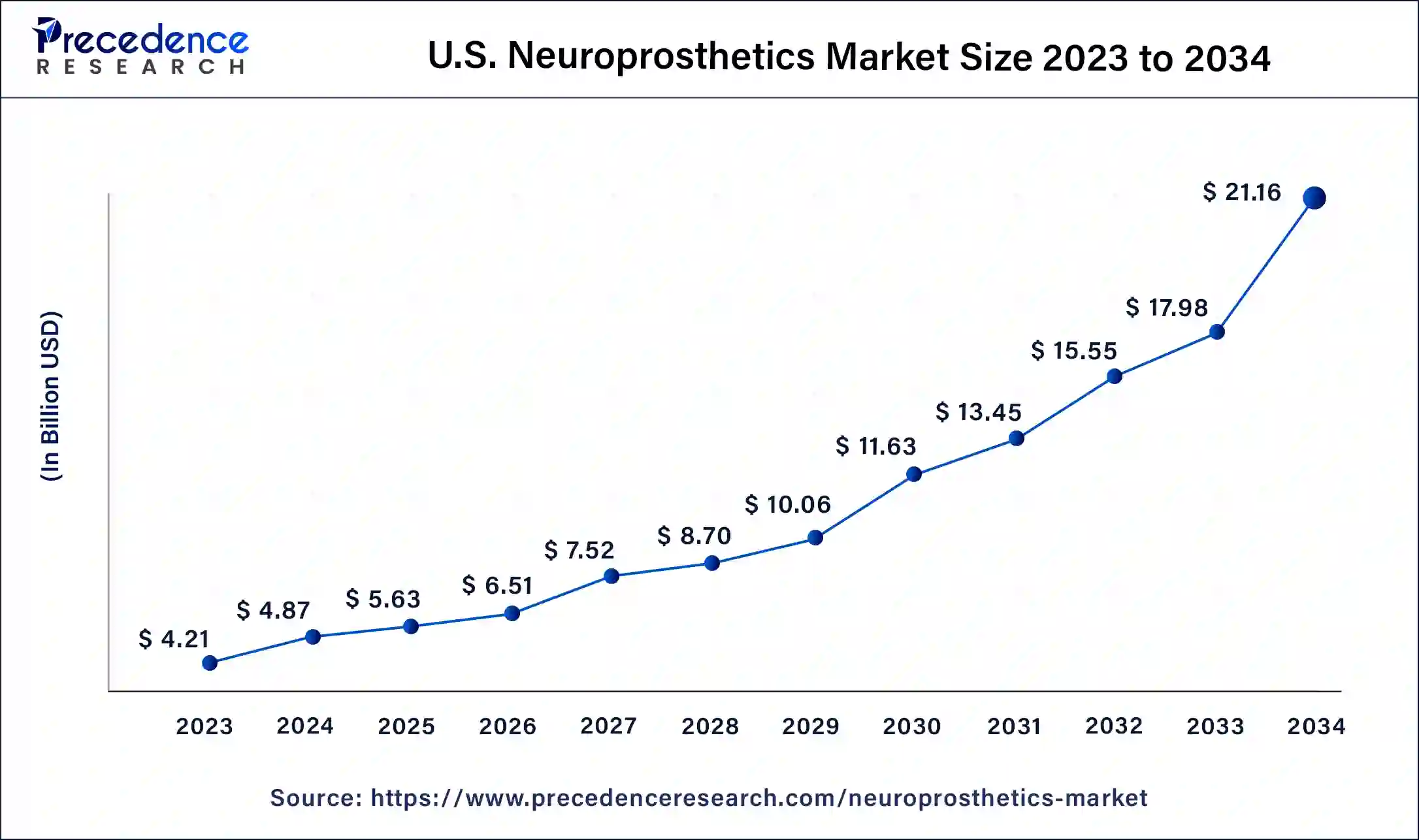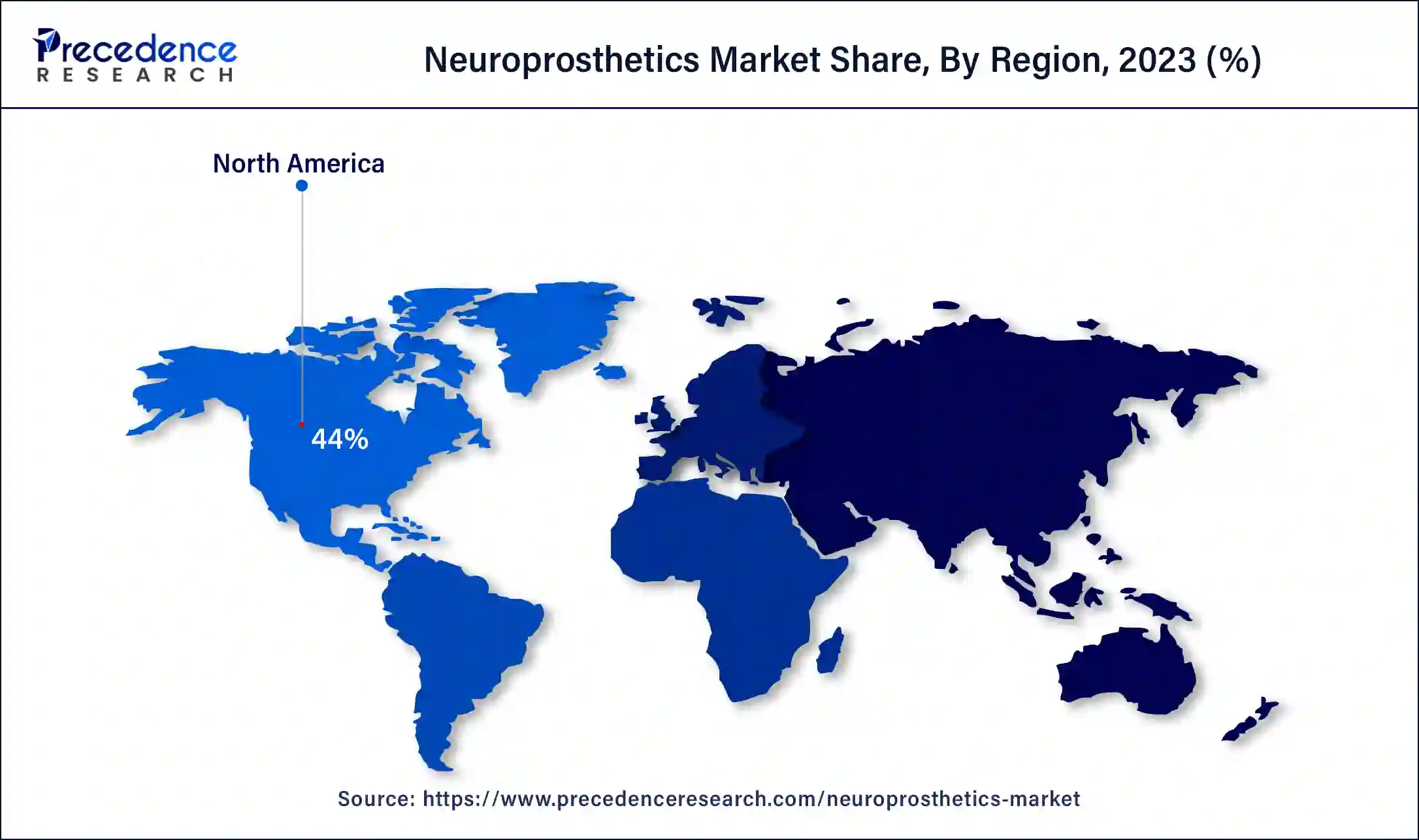The global neuroprosthetics market size surpassed USD 12.76 billion in 2023 and is estimated to increase from USD 14.75 billion in 2024 to approximately USD 62.98 billion by 2034. It is projected to grow at a CAGR of 15.62% from 2024 to 2034.
The global neuroprosthetics market size is projected to be worth around USD 62.98 billion by 2034 from USD 14.75 billion in 2024, at a CAGR of 15.62% from 2024 to 2034. The neuroprosthetics market is expanding due to advancements in brain-computer interface technology and increasing demand for enhanced prosthetic functionality.

The U.S. neuroprosthetics market size was exhibited at USD 4.21 billion in 2023 and is projected to be worth around USD 21.16 billion by 2034, poised to grow at a CAGR of 15.18% from 2024 to 2034.

North America led the global neuroprosthetics market in 2023. In North America, neurological disorders address a considerable challenge to general well-being. Neuroprosthetics and neurological treatments, including technological developments and the combination of AI and robotics, drive the market. To contract with the growing number of neurological disorders, public health initiatives are focusing on increasing healthcare infrastructure, subsidy research, and growing access to healthcare. There is a lot of Alzheimer's and Parkinson's disease, and there are constant efforts to progress diagnostic and treatment abilities. Additionally, hearing loss affects a significant portion of the population, necessitating programs for support and intervention.

Asia Pacific is expected to host the fastest-growing neuroprosthetics market throughout the forecast period. The fast extension is driven by expanded attention in medical services infrastructure, progressions in neuroprosthetic improvements, and a rise in neurological problems. The rising instances of disease in people drive the market growth.
Neuroprosthetics addresses a pivotal clinical innovation, using direct electrical stimulation of the nervous system for functional performance. These devices can either restore lost motor, sensory, or cognitive abilities brought on by illness or injury or introduce new capabilities. The ideal neuroprosthetic interface should provide long-term, consistent clinical benefits while enabling high-quality neural recording and stimulation. This field incorporates different advancements like assistive technology (AT), functional electrical stimulation (FES), myoelectric prostheses, robotics, virtual reality (VR) gaming, and brain stimulation.
A key breakthrough in the neuroprosthetics market has been the ability to interpret signals from the brain and convert them into valuable commands for prosthetic devices. This has opened the doors to restoring a significant degree of lost functionality in individuals with spinal cord injuries, stroke, or neurodegenerative diseases.
AI Integration in the Market
Combining artificial intelligence (AI) with neuroprosthetics has been a critical achievement in developing brain-computer interfaces (BCIs) in the neuroprosthetics market. This developing interaction aims to enhance the quality of life for individuals with disabilities by restoring lost sensory, motor, and cognitive functions. AI, a part of computer-based intelligence, has incredibly worked on understanding brain signals. This progression empowers the production of prosthetic gadgets that are fit for performing more complicated and nuanced assignments.
Key advancements in the neuroprosthetics market include customized prosthetics, expanded scope of functionality, and real-time adjustments. Machine learning algorithms, a branch of AI, are used to understand complex neural signals, permitting more precise and adaptable control of prosthetic devices. This has led to considerable advancements, such as prosthetic limbs that can accomplish a broader range of movements or cochlear implants that can be improved to filter out background noise.
| Report Coverage | Details |
| Market Size by 2034 | USD 62.98 Billion |
| Market Size in 2023 | USD 12.76 Billion |
| Market Size in 2024 | USD 14.75 Billion |
| Market Growth Rate from 2024 to 2034 | CAGR of 15.62% |
| Largest Market | North America |
| Base Year | 2023 |
| Forecast Period | 2024 to 2034 |
| Segments Covered | Type, Technology, Application, and Regions |
| Regions Covered | North America, Europe, Asia-Pacific, Latin America, and Middle East & Africa |
The rising number of neurological disorders
Neurological disorders include a wide range of diseases that affect the body's autonomic, peripheral, and central nervous systems. These non-transmittable issues incorporate circumstances like headaches, non-headache cerebral pains, multiple sclerosis, Alzheimer's illness and different dementias, Parkinson's infection, epilepsy, and other neurological conditions.
The rising number of neurological disorders-related deaths and disabilities is now recognized as a significant global public health issue. Diabetic neuropathy, specifically, has arisen as the quickest-developing neurological condition, with the number of people with diabetic neuropathy has more than tripled globally since 1990, rising to 206 million cases in 2021. This increase is in line with the worldwide rise in diabetes, thus fuelling the growth of the neuroprosthetics market globally.
Increase in the geriatric population
The rise in the geriatric population has prompted a rising predominance of neurological disorders, which emphasize the sensory system, including the cerebrum, spine, and nerves. These circumstances are presently the subsequent driving reason for death globally. As individuals age, the probability of creating neurological sicknesses increases fundamentally, influencing risk factors and clinical indications. The aging population, especially in low-income nations, presents notable difficulties for well-being and social consideration frameworks. A multidisciplinary approach is pivotal to tending to the developing burden of neurological infections among the older. With more than 600 known neurological circumstances going from regular headaches to severe illnesses like mind growth and amyotrophic parallel sclerosis, these issues are progressively successive among the geriatric population.
Ethical challenges
Considering that genuine protections are laid out for research subjects and patients, the likely advantages of examination into and therapeutic applications of neuroprosthetics offset the dangers and are, in this way, morally reasonable. Contingent upon their neurogenerative potential, there might be an ethical obligation to conduct this examination. Progress in neuroscience will continue to bring up new moral and philosophical issues about the mind and its capabilities. The upregulation versus reorganization debate emphasizes the challenge of determining the exact neural program the brain adopts during recovery of function after neurotrauma. This challenge is viewed as a critical boundary to developing the neuroprosthetics market.
Development of a minimally invasive procedure
Neural implants are designed to be as small as possible to be minimally invasive, particularly in areas surrounding the brain, eyes, or cochlea. These implants ordinarily convey remotely with their prosthetic partners and endure remote transmission employing the skin. The tissue surrounding the implant is usually susceptible to temperature rise, meaning power consumption must be minimal to prevent tissue damage.
These implants are used in neuromodulation and minimally invasive procedures to help people living with movement disorders, chronic pain, spasticity, and epilepsy robotic surgery, also known as robot-assisted surgery, is a minimally invasive surgical technique where specialized robotic systems are employed to assist surgeons in performing procedures with unparalleled precision and control. For treatment, robotics has been used to develop minimally invasive surgical procedures, including stereotactic and endoscopic methodologies and the designated conveyance of therapeutic agents to specific targets in the brain.
The motor prosthetics segment contributed the largest share of the neuroprosthetics market in 2023. The motor neuroprostheses are intended to re-establish motor capability through electrical excitement of designs engaged with development, like muscles, fringe nerves, the spinal line, or the mind, following neuromotor issues like stroke. These neuroprostheses come in different structures, including neurostimulation gadgets for muscles, fringe nerves, spinal rope, and implantable cerebrum machine interfaces. Motor prosthetics record the action from motor cortical regions connected with arm and hand developments.
The retinal implants segment is expected to show considerable growth in the neuroprosthetics market over the forecast period. The development of wireless retinal implants that can be powered and controlled externally reduces the need for invasive procedures and enhances patient comfort, contributing to market growth. Ongoing research and development in the field of neuroprosthetics have led to the creation of more effective retinal implants. Numerous clinical trials are underway, which, if successful, will likely lead to the commercialization of new products, further driving market expansion.
The spinal cord stimulation segment accounted for the largest share of the neuroprosthetics market in 2023. Spinal cord stimulation is a neuromodulation therapy for treating medically refractory chronic pain. In SCS, an embedded heartbeat generator produces electrical signs passed on through terminal exhibits situated in the locale of the spinal cord. SCS aims to adjust brain motion through the spinal and supraspinal systems to decrease torment.
The sacral nerve stimulation segment is anticipated to witness significant growth in the neuroprosthetics market over the studied period. A sacral nerve stimulation is a small transmitter embedded under the skin in the upper butt cheek region. It conveys delicate electrical driving forces through a test close to the sacral nerve. Like a pacemaker yet intended to stimulate the gut, sphincter, and bladder muscles to work usually, treatment helps people with bladder and gut issues.
The motor neuron disorders segment has generated the highest share of the neuroprosthetics market in 2023. Neuroprosthetic devices can substitute for motor, sensory, or cognitive functions impaired due to nervous system disorders. These disorders are progressive, leading to severe disability over time. As the disease advances, patients lose control of voluntary muscles, making neuroprosthetic devices essential for maintaining mobility and improving quality of life.
The cognitive disorders segment is expected to grow fastest in the neuroprosthetics market during the forecast period. Cognitive disorders are mental disorders characterized by impaired cognitive abilities and daily functioning in which biological causation is either known or presumed. These problems include disturbance in thinking or memory that address a massive change from the person's earlier degree of working and are brought about by physical or psychological circumstances or medication use as opposed to mental variables. For instance, insanity is brief, while dementia, like Alzheimer's sickness, is by and large moderate and steady. Medicines for mental issues, instead, treatments are designed to minimize patients' symptoms.
Segments Covered in the Report
By Type
By Technology
By Application
By Geography
For inquiries regarding discounts, bulk purchases, or customization requests, please contact us at sales@precedenceresearch.com
No cookie-cutter, only authentic analysis – take the 1st step to become a Precedence Research client